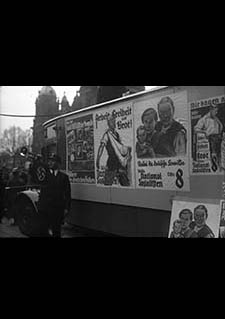The Rise of the NSDAP
When it was founded on February 24, 1920 in Munich, the National Socialist German Workers' Party (NSDAP) published a 25 point platform that rested on three central demands: abrogating the Peace Treaty of Versailles, strengthening the Volksgemeinschaft and stripping Jews of German citizenship.
Up until 1923, the party primarily attracted supporters in Bavaria. The NSDAP took the domestic political situation exacerbated by inflation and the Ruhr conflict as an opportunity for its “Beer Hall Putsch” on November 9, 1923. After the putsch had failed, the party was banned and Adolf Hitler was sentenced to five years of prison in a fortress. Already released in December of 1924, Hitler began to reorganize the NSDAP as a “Führer party”. The goal then was to seize power legally.
In the wake of the Reichstag elections of 1928, the NSDAP was the most prominent of the anti-Semitic and völkisch parties. The party attracted nationwide attention with its campaign against the Young Plan, undertaken together with the Stahlhelm and the DNVP.
Between 1925 and 1930, the number of party members rose from 27,000 to 130,000. Receptiveness to the NSDAP’s anti-capitalist, anti-liberal and anti-Semitic platform increased during the Great Depression with its record unemployment. The NSDAP gained a popular base among those groups of voters that had previously voted DNVP or a minor national party or had become nonvoters out of disappointment with the “bourgeois” parties. The NSDAP was able to gain disproportionately many supporters from the old middle class and from among small businesspeople, shop owners and small tradespeople.
In the charged atmosphere of domestic politics in 1930, the NSDAP became the second strongest party after the SPD when it received 18.3 percent of the ballots cast in the Reichstag elections on September 14. Although it was part of the governing coalition in Thuringia and Braunschweig, the NSDAP was perceived as a “movement”, unlike the “system parties”.
Social and foreign policy issues (the Treaty of Versailles and the Young Plan) were prominent in their propaganda. “Rabble-rousing anti-Semitism” had been muted since 1928 so as not to frighten off bourgeois circles. Basically, the party promised every social group whatever it desired. All of their partly contradictory demands were framed by radical nationalism and the propagation of a “Volksgemeinschaft”.
The Reichstag elections on July 31, 1932 made the NSDAP the strongest party in the Reichstag. In early 1933, Franz von Papen persuaded President Paul von Hindenburg to accept a coalition of NSDAP and DNVP under Hitler as chancellor. Von Papen believed he could “tame” Hitler. “Power was transferred” legally on January 30, 1933

